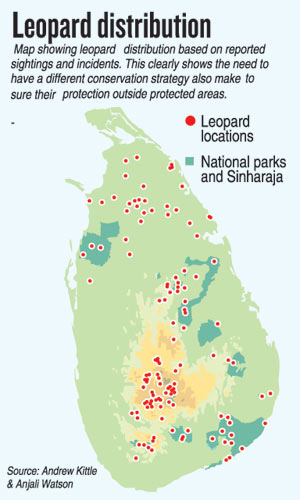News
Wire trap kills another Hill Country leopard
View(s):Adding to the increasing number of leopard deaths, an adult male, more than 7 feet long, was found dead in Nuwara Eliya, early this week, on September 21, having fallen prey to a wire trap.
The trap had been set up in Toppass village bordering the Piduruthalagala Forest Reserve and was meant to protect the agricultural lands from wild boar.
Wildlife enthusiast Kasun Pradeepa who saw the body of the animal around 9 a.m. on the day it was discovered said the animal would have died around six that same morning.

A male leopard was found dead in Nuwara Eliya, having fallen prey to a wire trap. Pic by Shelton Hettiarachchi
He said the snare had tripped around the leopard’s neck and death was either due to suffocation or the snare had snapped the animal’s neck.
This death comes even before the dust had settled on the Yala incident, where a speeding vehicle killed a female leopard inside the National Park.
Wire traps are known to be the number one killer of the elusive Hill Country leopard. In 2011, a leopard met the same fate in an area close to Toppas. Once the animal gets caught it struggles to break free and this worsens the situation and the animal dies of injuries to the internal vital organs.
“The Hill country is home for a viable leopard population. But wire traps pose a big problem although they are not aimed at killing leopard,” said Anjali Watson who is known for conducting research, along with Andrew Kittle on the Hill Country leopard.
“Wire traps are mainly set up for wild boar that comes to feed on farm lands. Wild boar is the leopard’s main prey, so they follow their path and become easy prey to the traps,” she said.
Unfortunately the land-use pattern of the Hill Country sometimes increases the conflict between leopards and humans, pointed out the researcher.
The Hill country has lots of small forest patches with tea estates in between. So the leopards often use these tea estates to cross from one forest patch to another or sometimes even make it their habitat, thereby making it vulnerable.
(M.R.)

